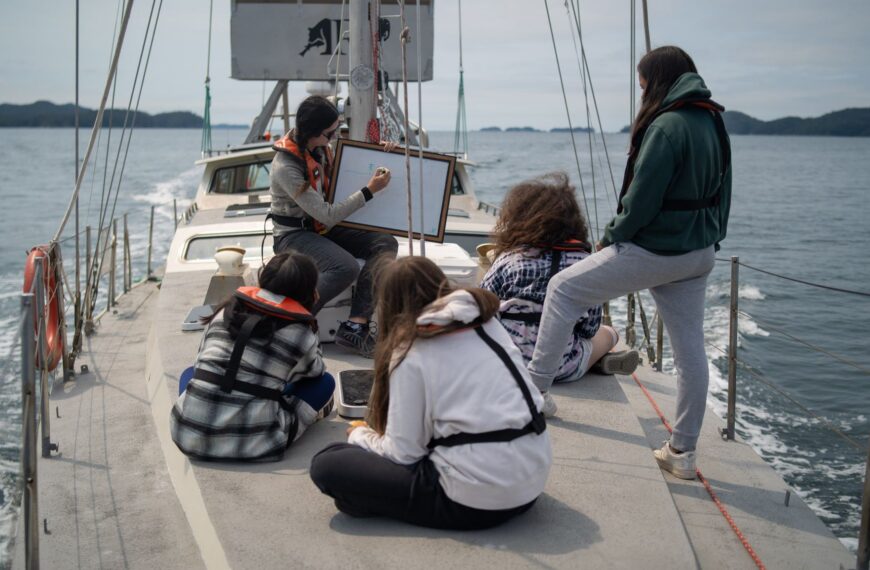Fisheries management and Canada’s Wild Salmon Policy
Context for Raincoast's Wild Salmon Program.
There is no question that fisheries management presents complex biological, economic, and political challenges. The status of salmon throughout most of BC and the US Pacific Northwest substantiates this difficulty. In the lower continental US, salmon have disappeared from 40% of their historic spawning range and many populations of wild salmon are protected under US Endangered Species legislation. Fisheries in the US are sustained largely by the producing hatchery fish. In British Columbia, the recent decades represent the lowest catches on record with all-time lows observed in Chinook and sockeye in the largest watersheds. As in the US, few of the fisheries in BC are now conducted on wild salmon. Most rely on the annual artificial propagation of fish from hatcheries.
Raincoast’s history on salmon work
Ghost Runs: salmon monitoring and status in BC’s Great Bear Rainforest
In 2008 and 2017, Raincoast and co-authors published papers on the status of salmon on BC’s central and north coast. Our original findings (Ghost Runs 2008) showed that salmon runs repeatedly failed to meet their spawning targets – meaning that not enough fish returned to spawn. Only 4% of monitored streams consistently met their escapement targets (by decade) since 1950. This paper also documented the erosion in the monitoring of salmon rivers and runs, creating a lack of ability to assess salmon health. By 2005, only 137 indicator streams (out of 2600 known salmon runs on the north and central coast) were being monitored.
In the 10 year update to this assessment (Conservation progress under Canada’s Wild Salmon Policy, we evaluated salmon status relative to the 2006 implementation of Canada’s Wild Salmon Policy. Our results showed that monitoring effort continued to erode, the abundance of spawning salmon continued to decline for several species, the status of many salmon Conservation Units were in zones of concern, and 42% of the Conservation Units that we assessed as Red (threatened) would have improved in status had the Canadian fishery been reduced.


Maximum Sustained Yield
Canada’s Wild Salmon Policy (WSP) states that the conservation of wild salmon and their habitat is the top priority in decision making. While a laudable goal, the reality is that fisheries management in Canada is embedded in a single species harvest approach that uses single generation stock-recruitment relationships to maximise fisheries harvest while minimizing the number of fish allowed to spawn. Fishing into spawner escapement goals is routine practice in Canada’s salmon management. Even the benchmarks used to guide fisheries management permit chronically low levels of salmon abundance (well below those needed to meet MSY) before fisheries are closed.
Even if Canada did manage for meeting its MSY goals, Maximum Sustainable Yield (MSY), has been criticized for its failure to safeguard fisheries and maintain ecosystem structure and function. Generally, these models provide a simple understanding of (often) complex ecological systems, they are overly optimistic of productivity, they don’t capture uncertainty, they downplay the risk of over-fishing, and they assume harvested “surplus’ fish have no role other than their purpose for human consumption. Still, conventional MSY remains the touchstone of salmon management in BC.
Considering wildlife: salmon for parks
Establishing protected salmon runs in protected watersheds
Coupled with lowered harvest rates to consider the food needs of wildlife, we believe it is time to establish protected salmon runs – runs that would be managed solely for their importance to wildlife and ecosystems. The paper Salmon for Parks (PDF) (2010 Conservation Letters) shows salmon runs that spawn in protected watersheds and parks are subjected to exploitation by commercial fisheries at levels as high as 80%. Often, these parks were created to protect species such as grizzlies, black/spirit bears and wolves that depend on salmon. Allowing salmon to reach their spawning grounds within protected areas without encountering the nets and hooks of the Pacific salmon fleet is a bold and ambitious proposal (because runs are only protected from harvest when they are greatly overfished or endangered), but we believe it is one the public is ready for, and is long overdue for fisheries management.
One of the most important shifts needed within fisheries management is ecosystem-based escapements (see Using grizzlies to assess harvest -ecosystem trade-offs 2012). Equally, salmon management should be “place based”, a concept that recognizes the connection wild fish have to their natal watersheds. Our paper Criteria for a good catch (2017 ) and adresses these considerations of sustainability. Ecosystems and place-based approaches would consider the trophic position of salmon in the food web, the needs of wildlife, the role of salmon nutrients in watershed processes, and environmental/climate uncertainty. In many cases, simply letting more fish spawn would meet many of these goals.
You can help
Raincoast’s in-house scientists, collaborating graduate students, postdoctoral fellows, and professors make us unique among conservation groups. We work with First Nations, academic institutions, government, and other NGOs to build support and inform decisions that protect aquatic and terrestrial ecosystems, and the wildlife that depend on them. We conduct ethically applied, process-oriented, and hypothesis-driven research that has immediate and relevant utility for conservation deliberations and the collective body of scientific knowledge.
We investigate to understand coastal species and processes. We inform by bringing science to decision-makers and communities. We inspire action to protect wildlife and wildlife habitats.










